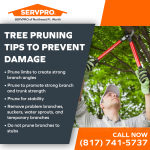SERVPRO® of Northeast Fort Worth is sharing five tips for pruning a tree to promote strong branches and reduce the potential for storm damage from broken limbs. Trees add real value to a home. A well-planned and well-pruned treescape create a beautiful setting for the home, and the trees produce shade from the hot summer sun. According to HGTV, “Several recent nationwide surveys show that mature trees in a well-landscaped yard can increase the value of a house by 7 percent to 19 percent.”

Unfortunately, trees can also create serious risk hazards for the homeowner and neighbors if the trees are not well managed. Occasionally, severe weather in the form of thunderstorms, hail, heavy rain, floods, and high winds roll through an area. Some trees survive the intense weather with negligible damage. A few small limbs fall on the roof and the ground, causing no damage to the home. Other trees suffer serious damage, including the loss of large limbs or significant sections of their branching structure. Damage may be catastrophic, with trees splitting in two or shearing off at the trunk. The services of qualified tree professionals are required to reshape the tree or remove it.
A tree weakened by disease is a risk to the property owner and neighbors. An unpredictable limb shed makes the tree dangerous. The best and safest solution may be to remove the tree before the dynamics of severe weather cause the tree to drop large limbs or topple over. Preventive measures are available to homeowners to help trees withstand the forces of extreme weather and avoid storm damage.
Tip #1. Prune limbs to create strong branch angles.
Deciduous trees such as oaks and maples may have branches that are too close together. The narrow angles between these limbs and branches create a weak point in the limb structure of the tree. Both the trunk and the crown can exhibit this situation. When two branches grow this close to each other, neither branch can add enough wood to make the limbs strong and resilient to storm damage. The limbs create a weak joint that can easily succumb to the stress of high winds. The solution is simple. If the branches are accessible and the tree is young, the homeowner can remove one of the two branches. The best branch strength is achieved when branch angles are at 10 o’clock or 2 o’clock.
Tip #2. Prune to promote the strong branch and trunk strength.
A tree needs balance. When balance and weight distribution are at odds, a tree can suffer limb and trunk damage. Moderate aggravation from storm conditions is all that is needed to send a tree crashing into a home. Branches on the side of the tree should be no more than 1/2 to 3/4 of the trunk width. Larger branches cannot be supported by the trunk and become a serious risk hazard when exposed to strong winds, ice, or snow.
Tip #3. Prune for stability.
Wind, ice, snow, sleet, or previous loss of a prominent limb can cause a situation where the center of gravity is not directly over the trunk. The tree responds under the slightest amount of wind pressure or extra weight with limb breaks, a broken trunk, or a toppled tree, including the roots. The selective removal of branches on the leaning side of the tree can realign the center of gravity and stabilize the tree. The tree is beautiful and safe for years to come.
Tip #4. Remove problem branches, suckers, water sprouts, and temporary branches.
When branches rub together, the friction causes wounds and decay that can lead to disease. The solution is to remove one of the branches. Water sprouts and suckers grow at the base of the trunk or inside the crown, and these branches do not add to the beauty of the tree but only serve to drain resources. For best results, remove these useless branches as soon as possible.
Temporary branches do not grow very high on a tree, and they serve to protect the tree from the sun. After year three or four, remove the temporary branches. Leaves are vital for survival, so when pruning, do not prune more than one-third of the leafy crown of the tree.
Tip #5. Do not prune branches to stubs.
New branches will emerge from the edges of the stub, and because these branches cannot unite firmly with the stubbed branch, the new branches will likely sustain damage in the future. Remove a branch where it connects to the main branch or the trunk. Never leave a stub.

For more information about storm damage restoration and flood restoration services, contact SERVPRO of Northeast Fort Worth by phone at (817) 741-5737. The damage restoration company can be reached by email at office@servpronortheastftworth.com.
































